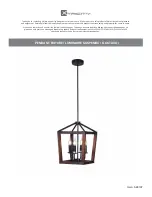
4.
Hazards
The laser product has been built in accordance with state-of-the-
art standards and the recognized safety rules. However, it might
cause hazards for persons or material property during use. If
you do not observe the accident prevention regulations, these
hazards may result in damage.
The following overview indicates the possible hazards that might
be caused by your laser product.
■
It indicates how
TRUMPF
has reduced the risk by applying
constructive measures.
■
You, as the user, can ensure safe operation of the laser
product by taking additional measures during its use.
4.1
Laser light
Solid state lasers generate laser light in the near infrared spec-
tral range (900-1250 nm). Using converters, the laser light can
also be produced in the visible range (400-700 nm) or in the
ultraviolet spectral region (< 400 nm).
Laser light may be hazardous to eyes and skin.
Depending on the severity of the danger, laser products are clas-
sified in
laser classes
.
The classification of the laser product in laser classes is defined
internationally in the EN 60825-1 and IEC 60825 standards.
The meaning of the laser classes is described briefly below. The
precise definition listing limit values can be found in the stand-
ards stated above.
Class 1 means that the laser light of this laser product is not
dangerous in standard operation.
The laser device is classified as class 1M (acc. to EN 60825-1)
if there may be a risk when observing laser light through optical
instruments.
A class 2 laser product only emits in the visible spectral region
(400-700 nm). A brief exposure does not involve any risk. Delib-
erate staring in the beam might be dangerous for your eyes.
Active reactions are sufficient to protect your eyes against dam-
age: Avert your eyes, move your head or close your eyes.
The laser device is classified as class 2M (acc. to EN 60825-1)
if there may be a risk when observing laser light through optical
instruments.
1
‐
8
Hazards
2022-03
12-29-01-A1-CRen
Laser class 1
Laser class 2
Summary of Contents for KF023
Page 1: ...Operator s manual Programmable focusing optics PFO 33 KF023...
Page 2: ......
Page 6: ...II Good to know 2022 03 12 29 01 A1 CRen...
Page 12: ...0 6 Table of contents 2022 03 12 29 01 A1 CRen...
Page 81: ...Protective glass monitoring active Fig 112272 12 29 01 A1 CRen 2022 03 Installation 2 43...
Page 90: ...2 52 Ambient conditions 2022 03 12 29 01 A1 CRen...
Page 112: ...3 22 Software 2022 03 12 29 01 A1 CRen...
Page 142: ...4 30 Adjusting the observation optics 2022 03 12 29 01 A1 CRen...
Page 170: ...5 28 Cooling water 2022 03 12 29 01 A1 CRen...
Page 176: ...6 6 Informing the service department 2022 03 12 29 01 A1 CRen...
















































